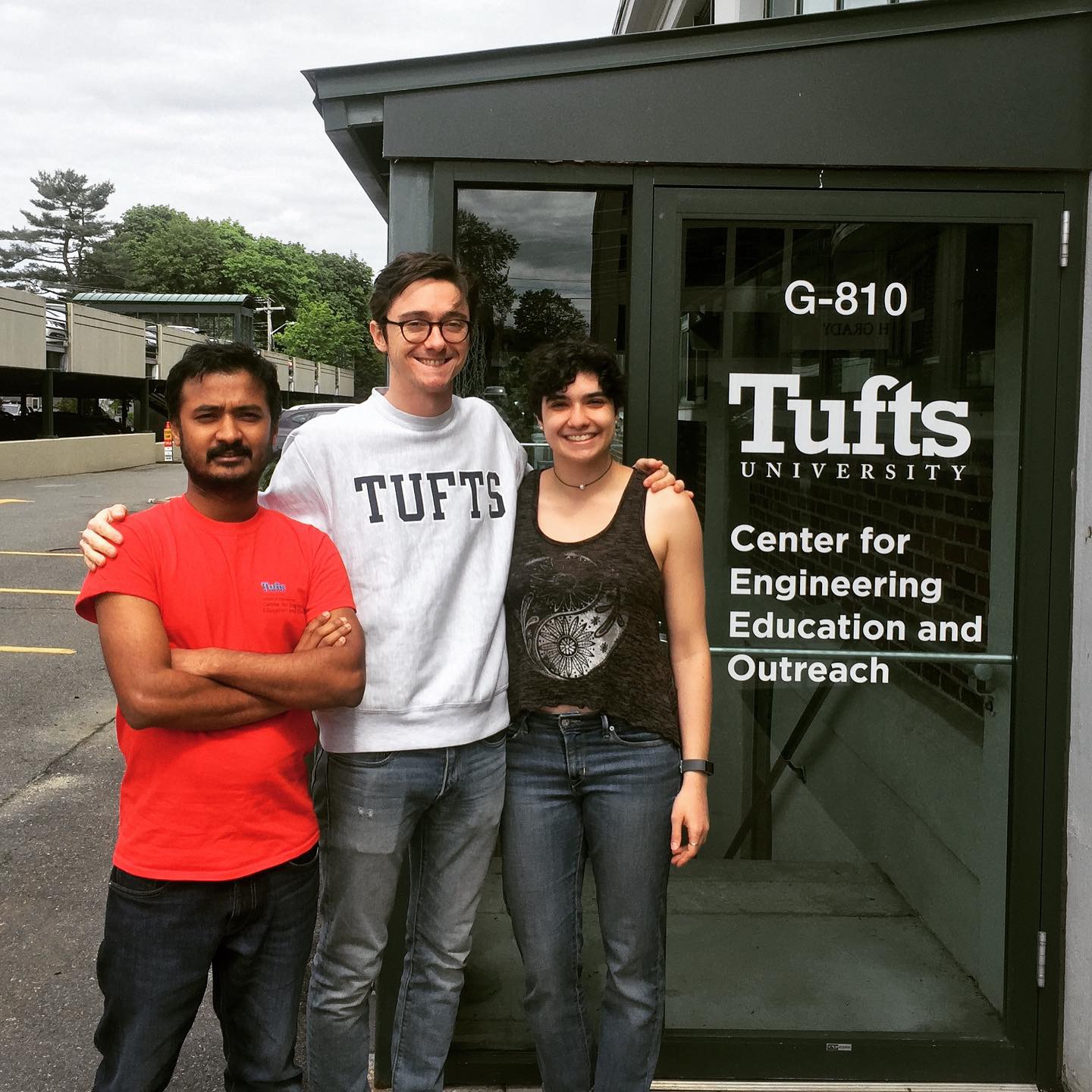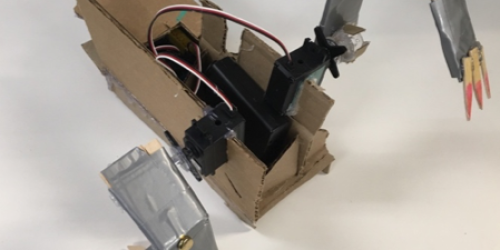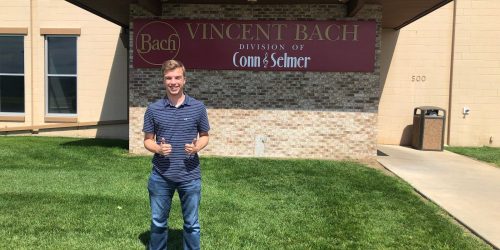Milan Dahal, Matthew Mueller, and Nicole Batrouny
Three graduate students working at Tufts Center for Engineering Education and Outreach (CEEO) on engineering education research will be graduating this May 2019. Matt Mueller has been working with us since he was a freshman at Tufts. He took Merredith Portsmore’s freshman robotics course, started working for our Student Teacher Outreach Mentorship Program (STOMP), then decided to stay and get his PhD in Engineering Education in Mechanical Engineering. Milan Dahal has been with us for two years working on his Masters in Human Factors Engineering while focusing on Makerspaces at a college level, an area we have not explored much here at CEEO. Milan has decided to continue working at CEEO for one more year as a staff member. Nicole Batrouny has been with us for 2 years. She just received her Masters in Mechanical engineering but will continue at Tufts to get her PhD. Her work has focused on collaborative decision making in K-12 classrooms. She will continue to do research at Tufts CEEO for professor Kristen Wendell. We are so proud of all of our graduating graduate students!
Below we have provided Matt, Milan, and Nicole’s theses and dissertation titles and abstracts.
NICOLE BATROUNY
Mechanical Engineering Masters Thesis
Student Strategies for Collaborative Disciplinary Decision Making in an Elementary Engineering Teaching Experiment
Elementary engineering education is implemented in a wide variety of ways, from after-school programs to student-led outreach to fully integrated, standards-based classroom instruction. In all of these, students are expected to perform complex practices of engineering while (usually) working in collaborative teams, which presents a slew of challenges to novice learners. To explore the sources of and potential tools for navigating these challenges, we designed a teaching experiment to support students in decision-making and groupwork. This thesis 1) describes the theory and instructional reasoning that informed the design of the teaching experiment and 2) presents a comparative case study analysis of three productive strategies that facilitated collaborative disciplinary decision making during the engineering design challenge: talking about plans, engaging in argument, and naming. These findings provide further characterization of the ways elementary students engage in engineering and reinforces the importance of argumentation as a skill and a practice for young engineering learners.
MILAN DAHAL
Human Factors Engineering Masters Thesis
Faculty Perception of Makerspaces
Makerspaces are getting increasingly popular in both educational and non-educational institutions all around the world. In the United States, almost every top university has a makerspace to provide their students with the opportunity to experience hands-on learning and enhance skills like creativity and innovation. In the past few years, Tufts has experimented with a number of makerspaces and has recently built a 5000 square feet campus-wide makerspace, Nolop FAST Facility. Despite the popularity of makerspaces in universities they still lack integration into the curriculum. In an effort to understand the underlying reasons for lack of makerspace integrated courses at Tufts I interviewed eleven faculty and surveyed eighty-two faculty from the School of Engineering and School of Arts and Sciences at Tufts University to learn about their perception of makerspaces and possibilities for integrating makerspaces in their courses. Analysis of data suggested that lack of experience in makerspace and lack of clarity of what is possible in makerspace were the most frequently reported perceived barriers that impacted faculty’s decision to integrate making and makerspace in their courses. The data from the surveys and interviews suggested marketing and holding discussions with the makerspace experts were some of the ways to encourage faculty participation. To show faculty what people have done in makerspace and inspire faculty to explore the possibilities of using makerspace I have built a documentation station for users to document their project works.
MATTHEW MUELLER
Mechanical Engineering Doctoral Dissertation
Understanding and Eliciting Engineering Science Practice: Exploring Beginner Embodiment Through Musical Instrument Design
While learning scientists have advocated for students to engage with the practices of science and engineering in addition to learning the content, engineering science is still broadly viewed as the math and science content particularly relevant to engineering design. Mechanical engineering faculty members, both practitioners and teacher of engineering science, were interviewed about the activities they use in their research projects and their learning goals for foundational science courses they teach to undergraduate students. A design based research study then explores how students can begin to enact engineering science practice when asked to conduct an investigation as part of a musical instrument design provocation. Learning environments for middle school students and undergraduates were developed to enable them to think like engineering scientists while generating knowledge about how their instrument produces sound. Multiple, descriptive case studies from each age group are presented, and student engagement is analyzed. Using a grounded theory methodology, I propose a framework made up of three main features, each with sub-activities, for understanding engineering science practice. (1) To determine the scope of their investigations, engineering scientists (a) recognize relevant variables, (b) limit their investigation to be productive given constraints, and (c) interpret implications of results and their reliability. (2) To apply science or math concepts and practices, they (a) apply a mechanistic understanding of the phenomenon, (b) use a domain specific understanding of how to mathematize the problem, and (c) reason scientifically about results. (3) Making decisions based on an awareness of economy, they (a) guide the investigation based on material resources (e.g. computational tools) or theoretical tools (e.g. nondimensionalization), and (b) decide how to invest resources based on their present understanding and time constraints. A phenomenography of how middle school students, university students, and faculty members can embody these practices is presented, along with principles for designing learning environments to elicit student engagement with them. One key finding is that the knowledge products generated by students at the end of a focused investigation are rich, multi-dimentional formative assessment tools for teachers. Future research directions are proposed to investigate engineering science learning in alternative, constructionist inspired learning environments.




